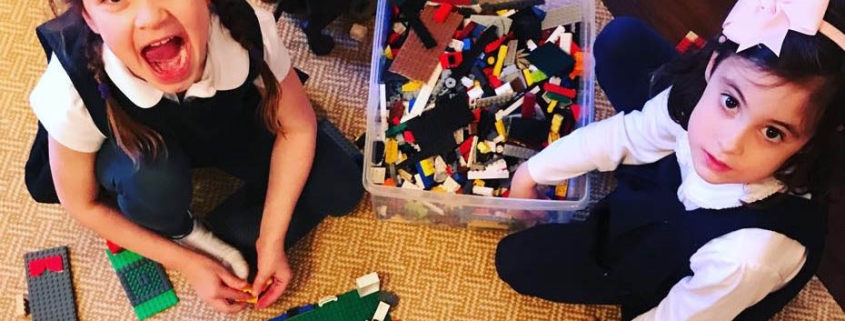Benefits of Block Play – and How to Inspire a Lifelong Love of Construction
From rudimentary wooden squares and rectangles to complex interlocking plastic Lego sets, block play is serious business for growing young minds. One of the great things about blocks is that they are a timeless toy that transcends all ages. In the words of playwright George Bernard Shaw, “We don’t stop playing because we grow old; we grow old because we stop playing.” We invite you to consider the many benefits of block play and to get involved with your child.
A Few Benefits of Block Play
There are countless advantages to block play, but spatial reasoning, math skills, and improved cognitive flexibility are among them.
- Spatial Reasoning is vital to investigating and solving problems. Spatial intelligence is used heavily in architecture, art, astronomy, construction, engineering, plumbing, technology, science, and surgery. A study of 51 preschoolers found that those most interested in block construction and built more sophisticated structures also performed best on a standardized test of spatial intelligence.
- Math skills improve when a child plays with blocks of different shapes, sizes, colors, and types. Researchers found that young children who were better at copying block structures performed better in early mathematics all the way through middle and high school. This is great news, whether your child is an aspiring financial analyst, computer programmer, medical scientist, actuary, data scientist, or math teacher.
- Cognitive flexibility is the ability to switch between two different concepts or to consider multiple concepts at once – in other words, “multi-task.” The chance of being successful in life greatly increase with the amount of cognitive flexibility a person has. One study found that cognitive flexibility greatly improved among preschoolers subjected to structured and unstructured daily block play activities, regardless of socioeconomic status.
Beyond these perks, educators use blocks in the classroom to improve social emotional skills, cooperation, sharing, problem-solving and empathy.
Ideas for Block Play at Any Age
Babies – Aim for soft blocks at this age, as everything goes into the mouth for exploration! These interactive Baby Einstein blocks feature different textures, a vibration effect, a mirror, and a variety of colorful pictures. Soft stacking blocks can provide endless hours of fun – even if you’re the one stacking and your baby’s the one toppling it down.
Toddlers – At this age, anything goes! Simply provide a variety of blocks – wood, foam, plastic, or whatever you have. They love shape and color sorting, carrying and dumping the blocks, stacking up towers and knocking them down. By preschool, most kids will start to experiment with building bridges, castles, roadways, and more complicated structures, while developing elaborate storylines involving their toys as characters. Magna-Tiles are an investment that will grow with your child. We’ve also gotten years of use out of Bristle Blocks. Magnetic “Tangram” pattern blocks can be a fun way to explore how different shapes come together to form larger structures.
1st Grade – 2nd Grade – Use food to create edible structures. Marshmallows, apples, cheese, crackers, and gum drops all work great — with toothpicks to hold it all together. The JELL-O “Play and Eat” kits are another fun way to play with your food, while honing those construction skills. For the summer months, take the fun outdoors by collecting loose items in a tote and setting up a building zone; use mirrors, crates, tree stumps, boulders, knitting spools, pom poms, pipe cleaners, popsicle sticks, felt pieces, kitchen utensils, pots, recycled containers, plastic pipes, and more. Use PVC pipes to construct a simple playhouse for dolls, a pulley system for action figures, or a more elaborate structure the kids can actually play inside themselves.
3rd Grade – 4th Grade – At this time, kids are able to put together more elaborate LEGO sets matched to their interests, though some kids just prefer creating their own structures using open-ended Classic bricks. More time is spent in planning, arranging for symmetry, and adding detail work. Dramatic play involving an assortment of toys is still prevalent. Video games like Minecraft allow children the opportunity to explore block-like figures in a virtual environment they can control. Marble runs and erector sets can take block building to the next level. Circuit Cubes appeals to older kids, inviting them to build tanks, mechs, robots, and other vehicles using more sophisticated materials.
Block Play for NYC Kids
Shine invites you to join Block Party, a constructive arts class geared to ages 4-10. Over multiple sessions, little architects will expand on traditional designs using a variety of materials, including sugar cubes, marshmallows, toothpicks, tree blocks, and more. Sculptural art projects translate block play into creative applications of all we’ve learned. Contact us for details.
Additional Resources:
https://www.parentingscience.com/toy-blocks.html
https://www.naeyc.org/resources/pubs/yc/mar2015/ten-things-children-learn-block-play
https://babyyumyum.co.za/7-benefits-of-block-play/
https://blog.schoolspecialty.com/steam-challenges-for-block-play-in-early-childhood/
https://docs.msl.mt.gov/librariesweb/documents/Ready2Read/PlaySpace/pg_rrps_stagesinblockplay.pdf
https://www.theempowerededucatoronline.com/2017/08/block-play-ideas.html/
https://littlebinsforlittlehands.com/best-structure-building-activities-kids/



